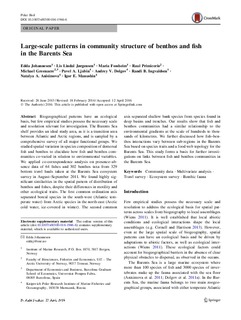| dc.contributor.author | Johannesen, Edda | |
| dc.contributor.author | Jørgensen, Lis Lindal | |
| dc.contributor.author | Fossheim, Maria | |
| dc.contributor.author | Primicerio, Raul | |
| dc.contributor.author | Greenacre, Michael | |
| dc.contributor.author | Ljubin, Pavel A. | |
| dc.contributor.author | Dolgov, Andrey V. | |
| dc.contributor.author | Ingvaldsen, Randi | |
| dc.contributor.author | Anisimova, Natalya A. | |
| dc.contributor.author | Manushin, Igor E. | |
| dc.date.accessioned | 2016-08-08T11:46:09Z | |
| dc.date.accessioned | 2016-08-09T10:19:53Z | |
| dc.date.available | 2016-08-08T11:46:09Z | |
| dc.date.available | 2016-08-09T10:19:53Z | |
| dc.date.issued | 2016-04-23 | |
| dc.identifier.citation | Johannesen, E., Jørgensen, L.L., Fossheim, M. et al. Polar Biol (2016). doi:10.1007/s00300-016-1946-6 | nb_NO |
| dc.identifier.issn | 1432-2056 | |
| dc.identifier.uri | http://hdl.handle.net/11250/2398350 | |
| dc.description | - | nb_NO |
| dc.description.abstract | Biogeographical patterns have an ecological basis, but few empirical studies possess the necessary scale and resolution relevant for investigation. The Barents Sea shelf provides an ideal study area, as it is a transition area between Atlantic and Arctic regions, and is sampled by a comprehensive survey of all major functional groups. We studied spatial variation in species composition of demersal fish and benthos to elucidate how fish and benthos communities co-varied in relation to environmental variables. We applied co-correspondence analysis on presence–absence data of 64 fishes and 302 benthos taxa from 329 bottom trawl hauls taken at the Barents Sea ecosystem survey in August–September 2011. We found highly significant similarities in the spatial pattern of distribution of benthos and fishes, despite their differences in motility and other ecological traits. The first common ordination axis separated boreal species in the south-west (Atlantic temperate water) from Arctic species in the north-east (Arctic cold water, ice-covered in winter). The second common axis separated shallow bank species from species found in deep basins and trenches. Our results show that fish and benthos communities had a similar relationship to the environmental gradients at the scale of hundreds to thousands of kilometres. We further discussed how fish–benthos interactions vary between sub-regions in the Barents Sea based on species traits and a food web topology for the Barents Sea. This study forms a basis for further investigations on links between fish and benthos communities in the Barents Sea. | nb_NO |
| dc.language.iso | eng | nb_NO |
| dc.publisher | Springer | nb_NO |
| dc.rights | Navngivelse-DelPåSammeVilkår 3.0 Norge | * |
| dc.rights.uri | http://creativecommons.org/licenses/by-sa/3.0/no/ | * |
| dc.title | Large-scale patterns in community structure of benthos and fish in the Barents Sea | nb_NO |
| dc.type | Journal article | nb_NO |
| dc.type | Peer reviewed | nb_NO |
| dc.date.updated | 2016-08-08T11:46:09Z | |
| dc.subject.nsi | VDP::Landbruks- og fiskerifag: 900::Fiskerifag: 920::Ressursbiologi: 921 | nb_NO |
| dc.subject.nsi | VDP::Agriculture and fisheries science: 900::Fisheries science: 920::Resource biology: 921 | nb_NO |
| dc.source.pagenumber | 10 s. | nb_NO |
| dc.source.journal | Polar Biology | nb_NO |
| dc.identifier.doi | 10.1007/s00300-016-1946-6 | |
| dc.identifier.cristin | 1361321 | |
| dc.relation.project | Norges forskningsråd: 200793 | nb_NO |

